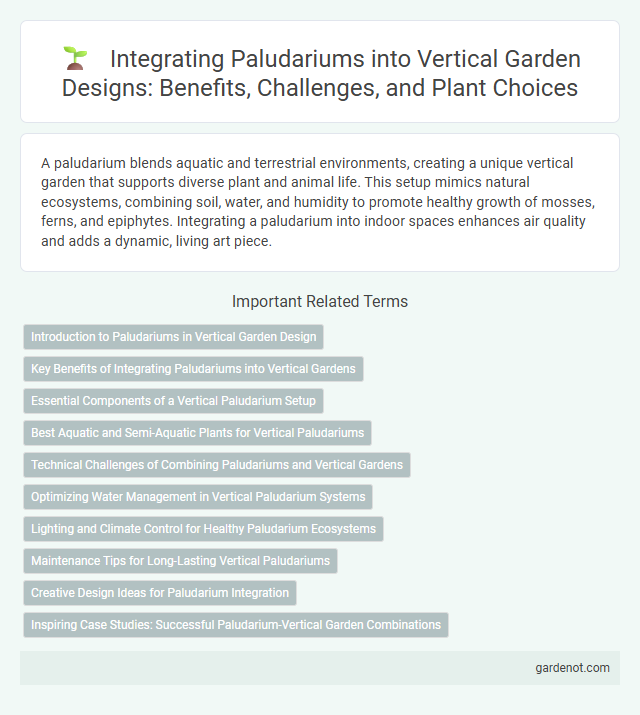A paludarium blends aquatic and terrestrial environments, creating a unique vertical garden that supports diverse plant and animal life. This setup mimics natural ecosystems, combining soil, water, and humidity to promote healthy growth of mosses, ferns, and epiphytes. Integrating a paludarium into indoor spaces enhances air quality and adds a dynamic, living art piece.
Introduction to Paludariums in Vertical Garden Design
Paludariums integrate aquatic and terrestrial elements, creating a dynamic environment that enhances vertical garden designs with lush plant variety and water features. These systems support diverse flora and fauna, promoting biodiversity while improving air quality and aesthetic appeal in indoor spaces. Integrating paludariums requires careful planning of humidity, lighting, and water circulation to maintain a balanced ecosystem within the vertical garden structure.
Key Benefits of Integrating Paludariums into Vertical Gardens
Paludariums enhance vertical gardens by combining aquatic and terrestrial environments, promoting biodiversity and creating a self-sustaining ecosystem. They improve air quality through natural filtration and humidity regulation, supporting healthier microclimates. The integration of paludariums also adds unique aesthetic appeal and offers habitats for amphibians, enhancing ecological versatility in vertical garden designs.
Essential Components of a Vertical Paludarium Setup
A vertical paludarium setup requires essential components such as a waterproof back panel to support both aquatic and terrestrial environments, a robust filtration system to maintain water quality, and waterproof lighting that mimics natural sunlight for plant and animal health. Structural elements like a substrate layer for plant roots, an efficient drainage system to prevent waterlogging, and high humidity controls are crucial for sustaining diverse flora and fauna. Incorporating live plants, such as ferns and mosses, alongside aquatic species enhances the ecosystem's balance and promotes oxygenation within the vertical paludarium.
Best Aquatic and Semi-Aquatic Plants for Vertical Paludariums
Hydrocotyle leucocephala and Cryptocoryne wendtii excel as top aquatic plants for vertical paludariums due to their compact growth and adaptability to submerged conditions. Semi-aquatic species like Anubias barteri and Java fern thrive on vertical surfaces with high humidity, offering lush foliage that enhances the natural aesthetic. Incorporating these plants ensures optimal oxygenation, water filtration, and vibrant biodiversity in vertical paludarium setups.
Technical Challenges of Combining Paludariums and Vertical Gardens
Integrating paludariums with vertical gardens presents technical challenges such as managing precise water flow to support both aquatic and terrestrial plants without causing water damage or mold in vertical structures. Maintaining appropriate humidity levels and preventing root rot while ensuring adequate lighting for diverse plant species requires advanced environmental control systems. Structural reinforcement is essential to support the combined weight of water-filled tanks and densely planted vertical panels.
Optimizing Water Management in Vertical Paludarium Systems
Optimizing water management in vertical paludarium systems involves precise control of humidity levels and efficient recirculation techniques to maintain aquatic and terrestrial balance. Incorporating automated drip irrigation and recapture systems reduces water waste while promoting healthy plant growth and stable microclimates. Advanced filtration and sensor-based monitoring further enhance water quality, preventing stagnation and supporting biodiversity within the vertical garden ecosystem.
Lighting and Climate Control for Healthy Paludarium Ecosystems
Effective lighting in paludariums must mimic natural sunlight to support photosynthesis in aquatic and terrestrial plants, with full-spectrum LED lights being the most energy-efficient option. Maintaining optimal climate control involves regulating temperature and humidity levels to match specific species' needs, often achieved through automated thermostats, misting systems, and ventilation fans. Balancing light intensity and microclimate conditions ensures healthy growth and biodiversity within paludarium ecosystems.
Maintenance Tips for Long-Lasting Vertical Paludariums
Maintaining a vertical paludarium requires consistent monitoring of humidity levels between 70% and 90% to support both aquatic and terrestrial plants. Regularly removing dead leaves and algae prevents decay and maintains water clarity, promoting a healthy ecosystem. Employing a quality filtration system and scheduling bi-weekly water changes help sustain optimal water conditions for long-lasting vertical paludariums.
Creative Design Ideas for Paludarium Integration
Incorporate diverse aquatic and terrestrial plants to create dynamic vertical gardens within paludarium setups, enhancing biodiversity and visual depth. Use tiered water features and driftwood to establish natural habitats that support amphibians and fish while promoting humidity and airflow. Select LED grow lights with adjustable spectrums to optimize photosynthesis and plant growth, ensuring vibrant and healthy ecosystems.
Inspiring Case Studies: Successful Paludarium-Vertical Garden Combinations
Successful paludarium-vertical garden combinations showcase innovative integration of aquatic and terrestrial ecosystems, creating visually stunning and biologically diverse living walls. Notable case studies include the Singapore Changi Airport's indoor paludarium-vertical garden, which combines lotus ponds with lush tropical plants to enhance air quality and passenger experience. These projects demonstrate effective use of humidity control, plant selection, and automated irrigation systems to maintain dynamic and sustainable habitats.
Paludarium Infographic

 gardenot.com
gardenot.com